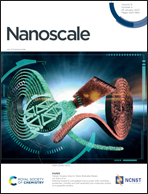A fluorescent sensor based on the cascade signal amplification strategy for ultra-sensitive detection of Cu2+†
Abstract
Copper is an essential element in the human body, participating in various physiological activities in the bodies of organisms. However, an excessive load of Cu2+ is associated with several neurodegenerative diseases and prion diseases, also identified as a symptom of Wilson's disease (WD). A straightforward, rapid, sensitive, and specific copper sensor is highly required but remains a challenge. In this study, guided by the simulation, we developed a chemical sensor using a cascade signal amplification strategy based on the Cu-catalyzed click reaction, combined with a fluorescence-enhanced substrate with gold nanorods coupled with silver nanoislands. The sensor can selectively detect Cu2+ as low as 3.87 nM within 10 min. We have demonstrated that this method can be directly employed for WD diagnosis in urine samples. In addition, using antibiotic susceptibility testing (AST) as an example, we verify whether this assay can be adapted to other targets where Cu is designed as an indirect indicator.



 Please wait while we load your content...
Please wait while we load your content...